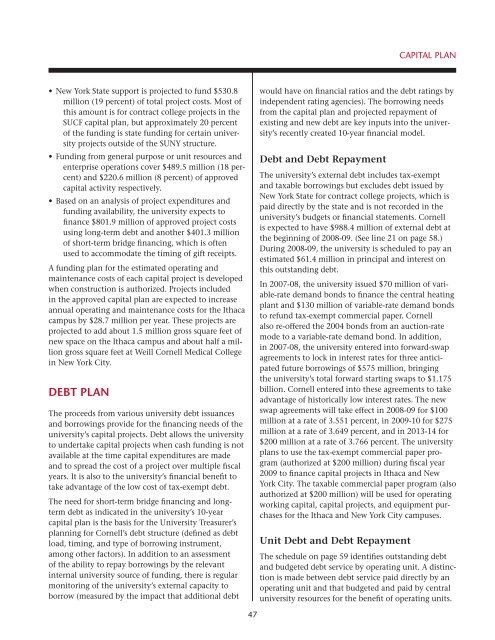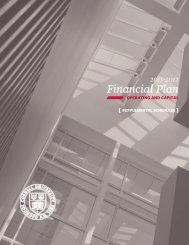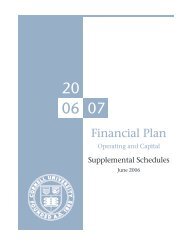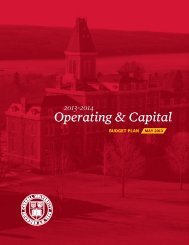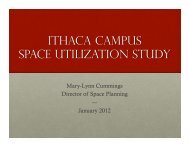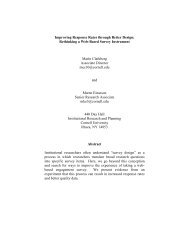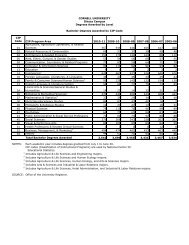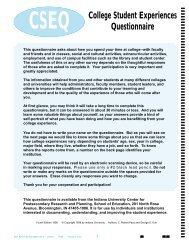Capital <strong>Plan</strong>struction (and include a funding plan); are facilities inthe “Far Above” campaign; are ongoing maintenanceor infrastructure projects; or are part <strong>of</strong> the 2004-09State <strong>University</strong> Construction Fund (SUCF) capitalplan. Not shown in project-level detail, but representedin the table at the bottom <strong>of</strong> page 57, are categorytotals for projects that are under consideration withinthe plan’s time horizon, including projects proposedfor the 2008-13 SUCF capital plan, but which mayhave scope, schedule, or funding being determined.Finally, as part <strong>of</strong> the university’s capital planning,additional capital needs have been identified that arebeing contemplated, but which are beyond the currentfundraising campaign or the next SUCF capital plan ordo not have identified or approved funding.• The university has authorized $1.178 billion <strong>of</strong>capital activity on projects with an estimated totalultimate budget <strong>of</strong> $2.785 billion. In the case<strong>of</strong> projects included in the amount allocated bySUCF as part <strong>of</strong> its capital budgeting process, eachproject is subject to the university’s capital approvalprocess as it proceeds through design andconstruction phases.• Of the approved project costs, $669.7 million hasbeen spent to date. If future projects proceed asplanned, expenditures during 2008-09 will total$475.8 million, and an estimated $1.788 billionwill be spent through 2012-13. Projects underconsideration but yet to be approved are estimatedto add $1.465 billion to total costs, with $992.5million <strong>of</strong> expenditures during the next five years.Projects supporting the priorities <strong>of</strong> the Far Abovecapital campaign and in areas <strong>of</strong> strategic researchmake up $860.0 million, or 44 percent, <strong>of</strong> the list <strong>of</strong>approved capital activity for the Ithaca campus.• Projects to improve undergraduate education andcreate a living/learning environment includemajor reconfiguration <strong>of</strong> West Campus residentialfacilities and new facilities for the College <strong>of</strong>Human Ecology (North Martha Van Rensselaerreplacement), the Faculty <strong>of</strong> Computing and InformationScience (Gates Hall), the Department <strong>of</strong>Architecture (Milstein Hall), and various humanitiesdepartments (new humanities building).• Support <strong>of</strong> strategic research areas includes theconstruction <strong>of</strong> a life sciences technology building(Weill Hall), construction <strong>of</strong> a new facility forthe physical sciences, and construction <strong>of</strong> a newfacility for the Animal Health Diagnostic Center inconjunction with the New York State Department<strong>of</strong> Agriculture and Markets.• Significant investments in the university’s informationtechnology infrastructure are underway,including a 15-year project to rewire the campusand upgrade the speed and capacity <strong>of</strong> the datanetwork, and investments in new and upgradedadministrative systems.• Projects addressing operating unit program needsinclude the renovations <strong>of</strong> Helen Newman Halland expansion <strong>of</strong> the Johnson Museum <strong>of</strong> Art.• Major utility projects include an expansion <strong>of</strong> heatingplant systems to increase steam generationand concurrently generate electricity and a variety<strong>of</strong> projects in the electric, steam, chilled water,potable water, sewer, and other areas as well asenergy conservation efforts. New parking structuresare planned as part <strong>of</strong> the North Martha VanRensselaer project and on <strong>University</strong> Avenue.• The university will continue its emphasis on maintainingand renewing existing buildings, whichis also the focus <strong>of</strong> the capital budget providedby SUCF for contract college facilities. Includedin the maintenance category are renovations <strong>of</strong>Stocking Hall in conjunction with the construction<strong>of</strong> a new Food Science building, the originalMartha Van Rensselaer Hall and East wing, Warren,Rice and Fernow Halls, and the Ives Facultybuilding and a large group <strong>of</strong> relatively smallermaintenance projects. A phased, multi-year effortto upgrade life-safety systems, replace the HVACsystem, and provide programmatic improvementsin Olin Library is planned. It is estimated that theapproved activity described herein will address$363.3 million <strong>of</strong> deferred maintenance.• The Medical College is planning the construction <strong>of</strong>a 413,000 gross square foot Biomedical ResearchBuilding and a series <strong>of</strong> renovations <strong>of</strong> laboratoriesand <strong>of</strong>fices for a variety <strong>of</strong> their departments.Nearly three-quarters <strong>of</strong> the funding for capital projectsdepends directly on external resources.• Gift and grant funding is projected at $1.544 billion,or 55 percent <strong>of</strong> the total approved capital activity.The estimated value <strong>of</strong> gifts in hand or pledgedfor approved projects is $488.4 million, leaving$1.055 billion to be raised.46
Capital <strong>Plan</strong>• New York State support is projected to fund $530.8million (19 percent) <strong>of</strong> total project costs. Most <strong>of</strong>this amount is for contract college projects in theSUCF capital plan, but approximately 20 percent<strong>of</strong> the funding is state funding for certain universityprojects outside <strong>of</strong> the SUNY structure.• Funding from general purpose or unit resources andenterprise operations cover $489.5 million (18 percent)and $220.6 million (8 percent) <strong>of</strong> approvedcapital activity respectively.• Based on an analysis <strong>of</strong> project expenditures andfunding availability, the university expects t<strong>of</strong>inance $801.9 million <strong>of</strong> approved project costsusing long-term debt and another $401.3 million<strong>of</strong> short-term bridge financing, which is <strong>of</strong>tenused to accommodate the timing <strong>of</strong> gift receipts.A funding plan for the estimated operating andmaintenance costs <strong>of</strong> each capital project is developedwhen construction is authorized. Projects includedin the approved capital plan are expected to increaseannual operating and maintenance costs for the Ithacacampus by $28.7 million per year. These projects areprojected to add about 1.5 million gross square feet <strong>of</strong>new space on the Ithaca campus and about half a milliongross square feet at Weill <strong>Cornell</strong> Medical Collegein New York City.Debt <strong>Plan</strong>The proceeds from various university debt issuancesand borrowings provide for the financing needs <strong>of</strong> theuniversity’s capital projects. Debt allows the universityto undertake capital projects when cash funding is notavailable at the time capital expenditures are madeand to spread the cost <strong>of</strong> a project over multiple fiscalyears. It is also to the university’s financial benefit totake advantage <strong>of</strong> the low cost <strong>of</strong> tax-exempt debt.The need for short-term bridge financing and longtermdebt as indicated in the university’s 10-yearcapital plan is the basis for the <strong>University</strong> Treasurer’splanning for <strong>Cornell</strong>’s debt structure (defined as debtload, timing, and type <strong>of</strong> borrowing instrument,among other factors). In addition to an assessment<strong>of</strong> the ability to repay borrowings by the relevantinternal university source <strong>of</strong> funding, there is regularmonitoring <strong>of</strong> the university’s external capacity toborrow (measured by the impact that additional debtwould have on financial ratios and the debt ratings byindependent rating agencies). The borrowing needsfrom the capital plan and projected repayment <strong>of</strong>existing and new debt are key inputs into the university’srecently created 10-year financial model.Debt and Debt RepaymentThe university’s external debt includes tax-exemptand taxable borrowings but excludes debt issued byNew York State for contract college projects, which ispaid directly by the state and is not recorded in theuniversity’s budgets or financial statements. <strong>Cornell</strong>is expected to have $988.4 million <strong>of</strong> external debt atthe beginning <strong>of</strong> 2008-09. (See line 21 on page 58.)During 2008-09, the university is scheduled to pay anestimated $61.4 million in principal and interest onthis outstanding debt.In 2007-08, the university issued $70 million <strong>of</strong> variable-ratedemand bonds to finance the central heatingplant and $130 million <strong>of</strong> variable-rate demand bondsto refund tax-exempt commercial paper. <strong>Cornell</strong>also re-<strong>of</strong>fered the 2004 bonds from an auction-ratemode to a variable-rate demand bond. In addition,in 2007-08, the university entered into forward-swapagreements to lock in interest rates for three anticipatedfuture borrowings <strong>of</strong> $575 million, bringingthe university’s total forward starting swaps to $1.175billion. <strong>Cornell</strong> entered into these agreements to takeadvantage <strong>of</strong> historically low interest rates. The newswap agreements will take effect in 2008-09 for $100million at a rate <strong>of</strong> 3.551 percent, in 2009-10 for $275million at a rate <strong>of</strong> 3.649 percent, and in 2013-14 for$200 million at a rate <strong>of</strong> 3.766 percent. The universityplans to use the tax-exempt commercial paper program(authorized at $200 million) during fiscal year2009 to finance capital projects in Ithaca and NewYork City. The taxable commercial paper program (alsoauthorized at $200 million) will be used for operatingworking capital, capital projects, and equipment purchasesfor the Ithaca and New York City campuses.Unit Debt and Debt RepaymentThe schedule on page 59 identifies outstanding debtand budgeted debt service by operating unit. A distinctionis made between debt service paid directly by anoperating unit and that budgeted and paid by centraluniversity resources for the benefit <strong>of</strong> operating units.47
- Page 5 and 6: Operating plan - highlightsIntroduc
- Page 8: Operating plan - highlightsComposit
- Page 11 and 12: Tuition, Financial Aid & Endowmentm
- Page 13 and 14: Tuition, Financial Aid & Endowmentu
- Page 15 and 16: Tuition, Financial Aid & EndowmentC
- Page 17 and 18: Tuition, Financial Aid & Endowmentf
- Page 19 and 20: Tuition, Financial Aid & EndowmentD
- Page 21 and 22: Tuition, Financial Aid & EndowmentC
- Page 23 and 24: Tuition, Financial Aid & EndowmentS
- Page 25 and 26: Tuition, Financial Aid & Endowmentw
- Page 27: Tuition, Financial Aid & Endowmentt
- Page 31 and 32: Tuition, Financial Aid & Endowmentp
- Page 33 and 34: Operating plan - DetailsIthaca Camp
- Page 35 and 36: Operating plan - DetailsSignificant
- Page 37 and 38: Operating plan - Detailstive staff
- Page 39 and 40: Operating plan - Detailsand develop
- Page 41 and 42: Operating plan - DetailsCentrallyOt
- Page 43 and 44: Operating plan - DetailsMedical Col
- Page 45: Capital PlanDistribution of Space -
- Page 49 and 50: Capital PlanFUNDING SOURCESFINANCIN
- Page 51 and 52: Capital PlanEXPENDITURE PATTERNEsti
- Page 53 and 54: Capital PlanFUNDING SOURCESFINANCIN
- Page 55 and 56: Capital PlanEXPENDITURE PATTERNEsti
- Page 57 and 58: Capital PlanEXPENDITURE PATTERNEsti
- Page 59 and 60: Capital PlanDebt Service by Operati
- Page 61 and 62: BStudent Fees and Other Tuition Rat
- Page 63 and 64: DUndergraduate Tuition, Fees, Room,
- Page 65 and 66: FAverage Nine-Month Faculty Salarie
- Page 67 and 68: HNew York State AppropriationsSourc
- Page 69 and 70: JInvestment Assets, Returns, and Pa
- Page 71 and 72: LGifts/Contributions - Through Marc
- Page 73 and 74: NWorkforce - Ithaca Campus2007-08 I
- Page 75 and 76: PU.S. Senate ResponseThe Senate Com
- Page 77 and 78: U.S. Senate Response (continued)of
- Page 79 and 80: U.S. Senate Response (continued)inc
- Page 81 and 82: U.S. Senate Response (continued)fro
- Page 83 and 84: U.S. Senate Response (continued)Tab
- Page 85 and 86: U.S. Senate Response (continued)Tab
- Page 87 and 88: U.S. Senate Response (continued)Tab


